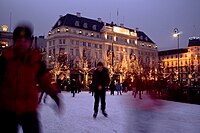Kongens Nytorv
The initiative moved the centre of the city from the medieval area around Gammeltorv, at that time a muddy medieval marketplace, to a cobbled new square with a garden complex, inspired by the Royal city planning seen in Paris from the early 17th century.
[1] Important buildings facing the square include the Royal Danish Theater from 1874, the Charlottenborg Palace from 1671 (now the Royal Danish Academy of Fine Arts), the Thott Palace from 1683 (now the French Embassy), the Hotel D'Angleterre and the Magasin du Nord department store.
In the beginning of the 17th century, the area later to become Kongens Nytorv was located outside the Fortifications of Copenhagen, as the eastern section of the ramparts, Østervold, ran along the western edge of the current square, with the eastern city gate, Østerport, located at the end of the street Østergade.
As part of Christian IV's ambitious plans to strengthen Copenhagen as a regional centre, he wanted to double the area of the fortified city, he acquired 200 hectares of land outside Østerport in 1606.
In the beginning of the 1640s the old Østervold was abandoned altogether in favour of the new ramparts further north, and the location of the King's new square, Kongens Nytorv, was decided in 1647 with the construction of the street Gothersgade in 1647.
According to a masterplan from created by the fortification engineer Axel Urups, Kongens Nytorv was to be connected to the sea by a canal.
[1] At this time, under the reign of Frederik III, the site was a chaotic area, dominated by remains of the old ramparts and piles of garbage, almost made unpassable when wet weather transformed it into a muddy morass.
Due to the topography and obstructed character of the premises, the site was popularly known as Hallandsåsen, a reference to the horst by the same name which had to be traversed when traveling from Scania and Halland.
This decision was taken mainly for military reasons, its strategic location with almost the same distance to all points along the ramparts of the city making it well suited as a central alarm square.
[2] Land around the new square was distributed among interested wealthy citizens, including people from the new ranks.
In 1688, a Baroque garden complex with trees around a parterre and a gilded equestrian statue of Christian V in its centre, was inaugurated.
With direct inspiration from the equestrian statue of Louis XIII erected at the centre of Place des Vosges in Paris in 1639,[1] it depicts the king dressed like a Roman imperator with a Laurel wreathed helmet.
Facing Charlottenborg Palace stand figures of Minerva and Alexander the Great, representing prudence and fortitude, while the opposite side features statues of Herkules and Artemisia, personifications of strength and honour.
It is now home to the Royal Danish Academy of Fine Arts as well as the exhibition space Kunsthal Charlottenborg.
In winter a 2,200 m2 (23,681 sq ft) circular ice skating rink is constructed around Krinsen.





